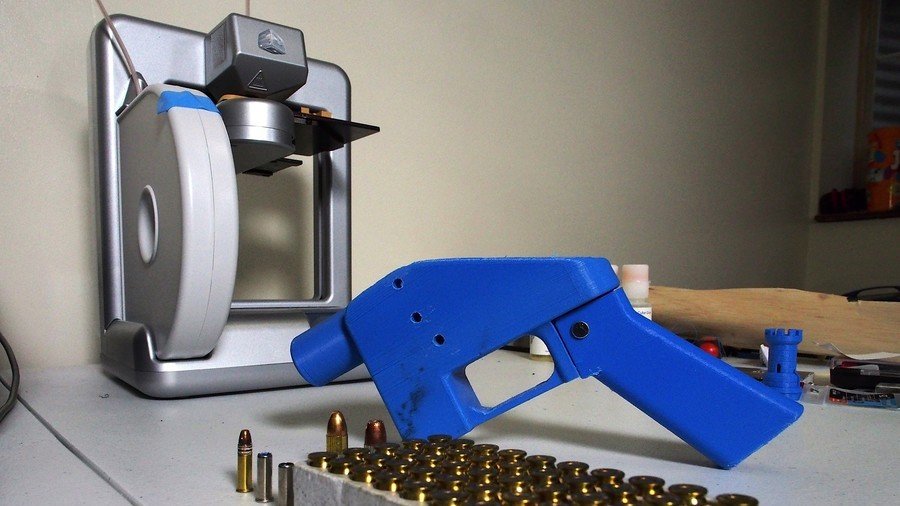Judge blocks release of 3D-printed gun blueprints hours before public launch

A federal judge in Seattle has blocked the release of downloadable plans for 3D-printed guns, hours before a Second Amendment activist was due to release them to the world.
US District Judge Robert Lasnik issued the temporary injunction on Tuesday, after eight Democratic attorneys general filed a lawsuit on Monday.
“These downloadable guns are unregistered and very difficult to detect, even with metal detectors, and will be available to anyone regardless of age, mental health or criminal history,” Washington state Attorney General Bob Ferguson said in a statement. “If the Trump Administration won't keep us safe, we will.”
The plans were due to be made public after the federal government reached a settlement with Defense Distributed, a Texas company that hosts and distributes the blueprints from its online depository, DEFCAD. Defense Distributed and DEFCAD are the creation of Cody Wilson, a pro-gun, libertarian activist.
The government had ordered Wilson to take down plans for a 3D-printed handgun in 2013. Wilson complied, but sued the government in 2015 and won the case in late June, with the Justice Department ruling that Americans may “access, discuss, use and reproduce” the plans.
Wilson, a self-described ‘crypto-anarchist’ hailed the victory as the death of American gun control.
Join Me https://t.co/OHIY9OQc0mpic.twitter.com/5meRcMSaEK
— Cody R. Wilson (@Radomysisky) July 10, 2018
While Judge Lasnik’s injunction came just before the official August 1 release date for the plans, Defense Distributed uploaded blueprints for nine types of gun to its website on Friday. The CAD files allowed anyone with the right software and access to a 3D printer to make their own weapons, including an AR-15 style rifle and a single-shot, disposable handgun.
According to Pennsylvania Attorney General Josh Shapiro, 1,000 people had downloaded Defense Distributed’s plans for an AR-15 style rifle by Sunday.
With a temporary injunction in place, President Donald Trump tweeted on Tuesday that he was “looking into” 3D printed guns, and consulting with the National Rifle Association on the issue.
I am looking into 3-D Plastic Guns being sold to the public. Already spoke to NRA, doesn’t seem to make much sense!
— Donald J. Trump (@realDonaldTrump) July 31, 2018
White House spokesman Hogan Gidley said that while people may have downloaded blueprints, owning or making a wholly plastic gun is illegal. Gidley said that the Trump administration “will continue to look at all options available to us to do what is necessary to protect Americans while also supporting the First and Second Amendments.”
DEFCAD, which hosted the blueprints since Wilson’s court victory in June, remains blank after Judge Lasnik’s injunction. While gun plans are now unavailable on the site, visitors can become members to fund the “direct, material expansion” of the Second Amendment.
How does it work?
During World War II, the US military manufactured the FP-45 Liberator, a single-shot pistol that could be mass-produced from stamped steel at a cost of $2.10 per unit. Dropped behind enemy lines to resistance fighters and partisans, the US intended these fighters to use the gun to kill Nazi occupiers at close range, before retrieving their weapons and carrying on the fight.
Drawing inspiration from this, Wilson posted plans for a 3D-printed ‘Liberator’ online in 2013. The single-shot, 3D-printed pistol could be manufactured with any commercially available 3D printer. While made entirely from plastic, the addition of a crude metal firing pin turned the Liberator into a viable weapon.
#guns#2A US judge blocks 3D printed gun blueprints hours before online release: Posted August 01, 2018 15:10:22 Photo: Company owner Cody Wilson holds a 'Liberator' pistol, which was fully 3D printed in his home. (AP: Jay Janner: https://t.co/EhtfN2yyqxpic.twitter.com/w9AfbKdPAD
— Gun Buyers Club (@GunBuyersClub) August 1, 2018
Plans for the liberator were downloaded more than 100,000 times in the two days before the US government ordered Defense Distributed to take them down. The schematics are still widely available on file-sharing sites like The Pirate Bay and on the ‘dark web.’
Undetectable plastic guns are illegal in the US, and become unsafe to use after firing a few rounds. To that end, Defense Distributed sells a milling machine called ‘Ghost Gunner,’ that allows inexperienced hobbyist millwrights to put the finishing touches to an 80 percent complete lower portion of a gun – which due to its unfinished nature can be sold as a lump of metal and not a firearm.
The finished lower is now considered a firearm. However, as it was home-machined from a chunk of unfinished metal, it has no serial number and its user did not have to pass a background check to get it. Making such a weapon for yourself is legal in every state except California, as long as you are not a prohibited person. The same rules apply for less durable 3D printed lowers.
So-called "80 percent lower receiver" rifle parts have to be machined to fit a firing mechanism, so the ATF doesn't consider them firearms pic.twitter.com/XWnfd3HWAQ
— The Trace (@teamtrace) July 31, 2017
Every other part – upper receiver, stock, grip, barrel, etc. - can either be 3D printed or bought with no restriction, as these parts are not considered firearms by themselves.
Several companies sell their own unfinished lowers and milling kits, and any number of plans for 3D printed parts circulate online. However, the prohibitive cost of 3D printers and high-precision CNC milling machines has thus far relegated homemade firearms to a small fringe of enthusiasts.
Wilson has stated that he wants to make untraceable ‘ghost guns’ accessible to the masses. His court victory and the backlash from legislators is the most high-profile case so far in what he calls “the age of the downloadable gun,” and has thrust the concept out of hobbyists’ workshops and into the mainstream.
Think your friends would be interested? Share this story!














